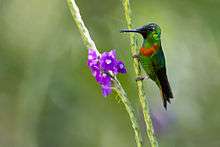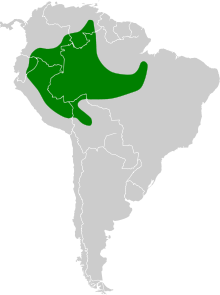Gould's jewelfront
| Gould's jewelfront | |
|---|---|
 | |
.jpg) | |
| Scientific classification | |
| Kingdom: | Animalia |
| Phylum: | Chordata |
| Class: | Aves |
| Order: | Apodiformes |
| Family: | Trochilidae |
| Genus: | Heliodoxa |
| Species: | H. aurescens |
| Binomial name | |
| Heliodoxa aurescens Gould, 1846 | |
 | |
| Synonyms | |
|
Gould's brilliant | |
The Gould's jewelfront (Heliodoxa aurescens) is a medium-sized hummingbird in the family Trochilidae. It is found in tropical and equatorial South America.[2] This is an uncommon species with an unusually large range compared to the other members of Heliodoxa.
The common name commemorates the English ornithologist and bird artist John Gould (1804–1881).[3]
Description
H.aurescens ranges in size from 11 to 12 cm, with an average weight of about 6.2g.[2] This is a sexually dimorphic species with minor differences in plumage and bill lengths between sexes. Both sexes have a narrow frontlet of glittering purplish-blue which is underdeveloped in immature individuals.[4] The bill, black[5] to dark coloured[2] is “unspecialised” being relatively short and straight;[6] while the irises are brown and tarsus black.[7] The tail is forked with the central pair of feathers bronze-green while the other tail feathers have chestnut edges and bronze-green tips. Undertail coverts are a deep fawn colour and wings are purplish-brown.[5] It is noted that there is some variation in plumage for this species, but these differences do not relate to location[8] and is minimal when considering the wide range.[2]
Specimens examined by Peter Cotton had an average wing length of 60.5mm[9] and exposed culmen length of 18.5mm.[10] Gould's original specimen had a bill of 2.5 cm and tail length of 31.75mm.[5] The average c-value of the genome is 1.1135pg based on four specimens ranging from 1.045-1.162pg.[11]
Males have shining grass green upperparts with the sides of the neck and lower throat glittering golden green bordered by a distinctive orange/rufous breast band. The chin, lores and upper throat are velvety black while the rest of the underparts are shining green.[2] Females appear generally similar to the male but are somewhat duller coloured and have a green crown. They have a slightly larger bill than the male (with a Lovich-Gibbons ratio of 0.030[12]). The chin feathers have buff tips and the throat is greyish with green discs. Females also feature a malar stripe (from the base of the bill towards the neck) which is buff to chestnut coloured.[2]
Systematics and taxonomy
Heliodoxa aurescens is one of nine species in the genus Heliodoxa (the “Brilliants”). It was first described by John Gould in 1846 who named it Trochilus aurescens.[5] It was later placed in the monotypic genus Polyplancta , however this was challenged as early as 1951 by Zimmer who suggested that it belonged in Heliodoxa.[8] Some ornithologists thought it to be closely related to the Brazilian Ruby (Clytolaema rubricauda) and sometimes placed it in Clytolaema.[2] Due to the absence of any synapomorphies in either grouping, it remained in Polyplancta until 1989 when morphological data indicated the species is embedded in Heliodoxa;[13] a finding confirmed by subsequent research.[14] These studies indicate it is closely related to the Black-throated brilliant (H.schreibersii), and may have evolved in parapatry to the Velvet-browed brilliant (H.xanthogonys).[15]
Distribution
The exact distribution of H.aurescens is not known, but considered unusual[16] since the other members of the genus have very narrow or restricted ranges, often at higher elevations in the Andes.[2][17] It is widely distributed at elevations from 250m[18] to 1150m[6] and has been reported at elevations as high as 1450m.[19] The northern boundary of the range is in southern Venezuela,[4] which continues south through central Ecuador and Peru.[2] The southern boundary is located in Bolivia.[20] It occupies a large area of north-western Brazil where the eastern boundary of the range is found in the State of Para.[2]
There have been several incidents of range expansion since the species was first described. Gould suggested the range was probably east of the Andes in Ecuador, Peru, and Brazil (in Zimmer[8]). The Venezuelan population was first encountered in 1941.[4] At this time, the southern boundary was considered to be La Pampa in Peru[21] but H.aurescens was detected in Bolivia in 1984[20] and in the Brazilian state of Mato Grosso in 2004.[22] Otherwise the species is considered sedentary.[2]
Habitat
H.aurescens is typically found in the understorey of lowland humid tropical forests, particularly near streams, and only rarely at forest edges.[2] In Brazil it has been observed in tall forest impacted by logging,[23] seen feeding at flowers in the canopy of “a small patch of semi-deciduous forest surrounded by terra firme”.[22] Cotton observed it in both varzea forest and terra firme but not in riverine vegetation.[9] Another Brazilian study found them in terra firme in both the wet and dry seasons but in várzea only during the dry season.[24]
In a one year survey in Columbia H.aurescens was found only in old secondary growth and never in young secondary growth or undisturbed understory;[25] but was observed in primary forest in a later survey.[17] It has been found both in mature floodplain forest[26] and terra firme[27] in Peru.
Diet
Like most hummingbirds, H.aurescens is primarily nectarivous supplementing the diet with small arthropods hawked from the air.[2] Little is known about the specific diet but they have been observed feeding on Bromeliads such as Bromelia balansae and Costus sp. in Brazil.[22] 53% of specimens examined in 1986 had traces of arthropods in the gut.[28] While typically a generalist understorey species, they have been observed feeding from flowers in tall trees;[22] and visiting feeding stations in Ecuador, where they showed some aggression towards other birds in the area.[19] An extensive study on feeding guilds in Brazilian hummingbirds indicated that H.aurescens was not generally territorial[9] but they were omitted from the analysis of food plant use due to there being too few observations,[10] with only three specimens netted in a two year survey.
Reproduction
Very little is known of the reproductive biology. Breeding is thought to occur between June and September with a clutch of two eggs incubated by the female.[2] Two descriptions of female specimens indicate their gonads are well developed in February[20] and April; but a single male specimen obtained in February had “small” gonads.[7]
Conservation status
H.aurescens is classified as Least Concern by the IUCN.[29] There are suggestions the species is in decline but not at a rate which warrants classification as endangered. Numerous studies indicate the species is present but uncommon, with many long term studies only producing small numbers of observations (E.G. Cotton 1998,[9] Lees et al., 2013[22]) A density of 1 individual per 100 hectares was determined in Peru when only one individual was observed in a 100Ha study site in a three month survey.[26]
References
- ↑ BirdLife International (2012). "Heliodoxa aurescens". IUCN Red List of Threatened Species. Version 2013.2. International Union for Conservation of Nature. Retrieved 26 November 2013.
- 1 2 3 4 5 6 7 8 9 10 11 12 13 14 del Hoyo, J.; Elliot, A.; Sargatal, J., eds. (1999). Handbook of the birds of the world. Volume 5. Barcelona: Lynx edicions. p. 615.
- ↑ Beolens, Bo; Watkins, Michael (2003). Whose Bird? Men and Women Commemorated in the Common Names of Birds. London: Christopher Helm. pp. 145–146.
- 1 2 3 Gilliard, E. (1941). "The birds of Mt. Auyan-Tepui, Venezuela". Bull Amer Mus Nat Hist. 77 (9): 439–508.
- 1 2 3 4 Gould, John (1846). "On twenty new species of Trochilidae or humming birds". Proc.Zool.Soc.Lond. 14: 85–90.
- 1 2 Feinsinger, P.; Colwell, R.K.; Terborgh, J.; Chaplin, S.B. (1979). "Elevation and the Morphology, Flight Energetics, and Foraging Ecology of Tropical Hummingbirds". The American Naturalist. 113 (4): 481–497. doi:10.1086/283408.
- 1 2 Willard, D.E.; Foster, M.S.; Barrowclough, G.F.; Dickerman, R.W.; Cannell, P.F.; Coats, S.L.; Cracraft, J.L.; O'Neill, J.P. (1991). "The birds of Cerro de la Neblina, Territorio Federal Amazonas, Venezuela.". Fieldiana- Journal of the Field Museum of Natural History, Chicago, Illinois. 65.
- 1 2 3 Zimmer, J.T. (1951). "Studies of Peruvian birds. No. 60. The genera Heliodoxa, Phlogophilus, Urosticte, Polyplancta, Adelomyia, Coeligena, Ensifera, Oreotrochilus, and Topaza". American Museum Novitates (1513): 1–45.
- 1 2 3 4 Cotton, P.A. (1998). "The hummingbird community of a lowland Amazonian rainforest". Ibis. 140: 512–521. doi:10.1111/j.1474-919x.1998.tb04613.x.
- 1 2 Cotton, P.A. (1998). "Coevolution in an Amazonian hummingbird-plant community". Ibis. 140: 639–646. doi:10.1111/j.1474-919x.1998.tb04709.x.
- ↑ Wright, N.A.; Gregory, T.R.; Witt, C.C. (2014). "Metabolic ‘engines’ of flight drive genome size reduction in birds". Proc. R. Soc. B. 281 (1779): 20132780. doi:10.1098/rspb.2013.2780.
- ↑ Berns, C.M.; Adams, D.C. (2013). "Becoming Different But Staying Alike: Patterns of Sexual Size and Shape Dimorphism in Bills of Hummingbirds". Evol Biol. 40: 246–260. doi:10.1007/s11692-012-9206-3.
- ↑ Gerwin, J.A.; Zink, R.A. (1989). "Phylogenetic Patterns in the Genus Heliodoxa (Aves: Trochilidae): An Allozymic Perspective". The Wilson Bulletin. 101 (4): 525–544.
- ↑ McGuire, J.A.; Witt, C.C.; Remsen, J.V.Jr.; Dudley, R.; Altshuler, D.L. (2009). "A higher-level taxonomy for hummingbirds". J Ornithol. 150: 155–165. doi:10.1007/s10336-008-0330-x.
- ↑ Weller, A.A.; Renner, S.C. (2001). "A new subspecies of Heliodoxa xanthogonys (Aves, Trochilidae) from the southern Pantepui highlands, with biogeographical and taxonomic notes". Brazilian Journal of Ornithology. 9: 1–5.
- ↑ Schulenberg, T.S. "Gould's Jewelfront (Heliodoxa aurescens)". Neotropical Birds Online. Cornell Lab of Ornithology. Retrieved 27 April 2015.
- 1 2 Salaman, P.G.W.; Donegan, T.M.; Cuervo, A.M. (1999). "Ornithological surveys in Serrania de 10s Churumbelos, southern Colombia". Cotinga. 12: 29–39.
- ↑ Walker, B.; Stotz, D.F.; Pequeño, T.; Fitzpatrick, J.W. (2006). Patterson, E.D.; Stotz, D.F.; Solari, S., eds. "Mammals and Birds of the Manu Biosphere Reserve, Peru". Fieldiana: Zoology, new series. 110: 23–49. doi:10.3158/0015-0754(2006)110[1:mabotm]2.0.co;2.
- 1 2 McHugh, C. (2008). "Flowers and Feeders: A Comparison of Hummingbird Feeding Activity". Independent Study Project (ISP) Collection. Paper 542. Retrieved 27 April 2015.
- 1 2 3 Schuchman, K.L. (1984). "Two hummingbird species new to Bolivia". Bull Brit Orn Club. 104 (1): 5–7.
- ↑ Bond, J. (1954). "Notes on Peruvian Trochilidae". Proceedings of the Academy of Natural Sciences of Philadelphia. 106: 165–183.
- 1 2 3 4 5 Lees, A.C.; Zimmer, K.J.; Marantz, C.A.; Whittaker, A.; Davis, B.J.W.; Whitney, B.M. (2013). "Alta Floresta revisited: an updated review of the avifauna of the most intensively surveyed locality in south-central Amazonia". Bull. B.O.C. 133: 178–239.
- ↑ Johns, A.D. (1991). "Responses of Amazonian Rain Forest Birds to Habitat Modification". Journal of Tropical Ecology. 7 (4): 417–437. doi:10.1017/s0266467400005812.
- ↑ Beja, P.; Santos, C.D.; Santana, J.; Pereira, M.J.; Marques, J.T.; Queiroz, H.L.; Palmeirim, J.M. (2010). "Seasonal patterns of spatial variation in understory bird assemblages across a mosaic of flooded and unflooded Amazonian forests". Biodivers Conserv. 19: 129–152. doi:10.1007/s10531-009-9711-6.
- ↑ Andrade, G.I.; Rubio-Torgler, H. (1994). "Sustainable Use of the Tropical Rain Forest: Evidence from the Avifauna in a Shifting-Cultivation Habitat Mosaic in the Colombian Amazon". Conservation Biology. 8 (2): 545–554. doi:10.1046/j.1523-1739.1994.08020545.x.
- 1 2 Terborgh, J.; Robinson, S.K.; Parker, T.A.; Munn, C.A.; Pierpont, N. (1990). "Structure and Organization of an Amazonian Forest Bird Community". Ecological Monographs. 60 (2): 213–238. doi:10.2307/1943045.
- ↑ Svensson, O. (2014). "Does small-scale land use affect the understory birds negative in the Peruvian National Reserve Allpahuayo Mishana?". DEGREE THESIS. Halmstad University.
- ↑ Remsen, J.V.Jr.; Stiles, F.G.; Scott, P.E. (1986). "Frequency of Arthropods in Stomachs of Tropical Hummingbirds". Auk. 103: 436–441.
- ↑ "Heliodoxa aurescens". The IUCN Red List of Threatened Species. Retrieved 27 April 2015.
External links
- Avibase
- IUCN Red List
- Catalogue of Life
- Xeno-Canto audio samples
- Lynx Edicions Handbook to the Birds of the World
- Birdlife International
- Cornell Ornithology Lab's Neotropical Birds Portal
- Gould's description in Proceedings of the Zoological Society of London
